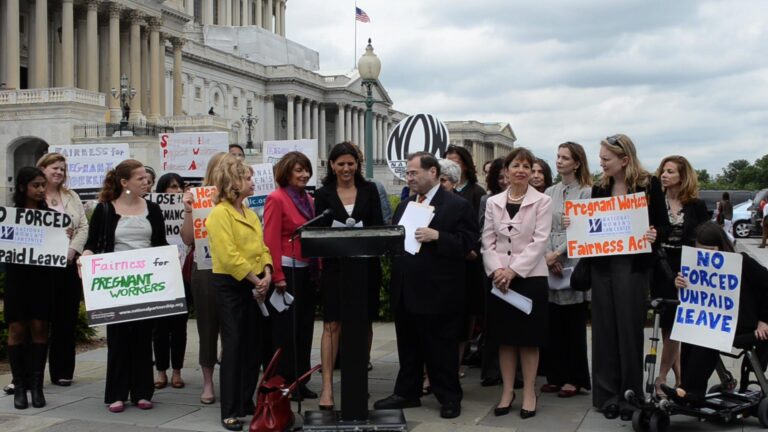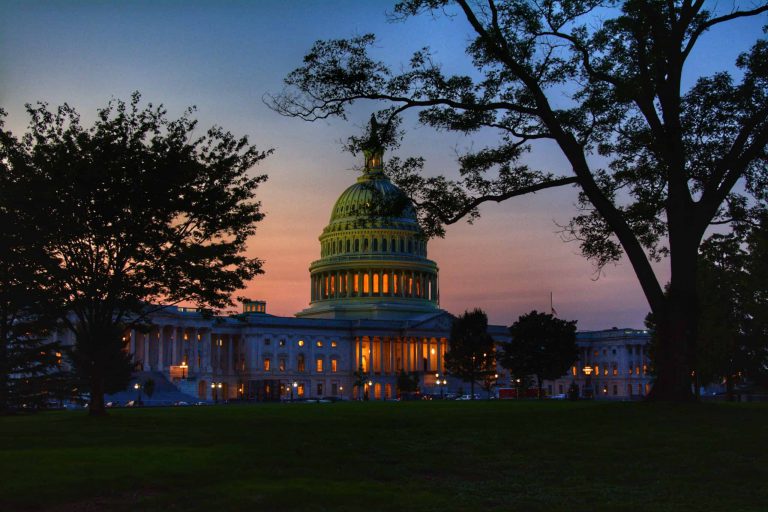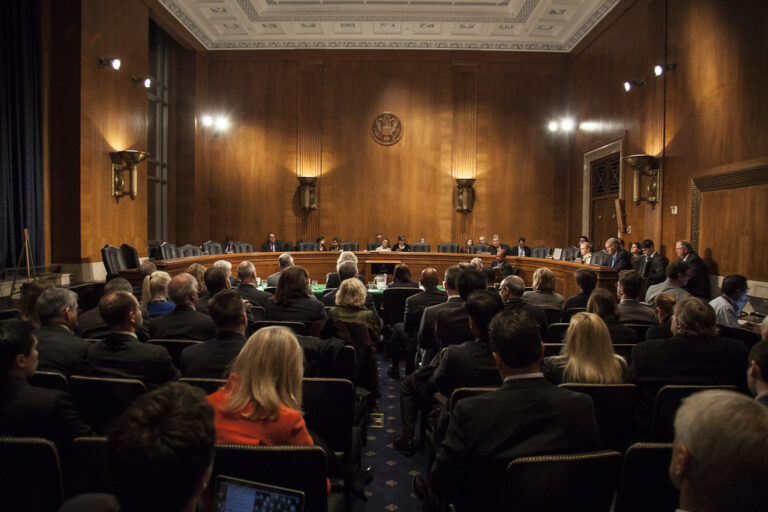
Ellie Samuels is a student at Harvard Law School.
Expecting mothers expect discrimination: one in five have feared telling a boss about their condition. They have good reason: one in five mothers say they have experienced pregnancy discrimination in the workplace. In 2019, the New York Times found many of the nation’s largest companies including Walmart, AT&T, and Whole Foods systematically deny advancement to pregnant workers and fire those who complain. Federal pregnancy discrimination filings with the Equal Employment Opportunity Commission (EEOC) have jumped 67% from 2016 to 2020 (with the biggest jump tied to the pandemic). Black women and women with low-wage jobs have filed a disproportionate share of these claims.
Existing federal laws have been a critical floor for pregnant workers, helping countless women participate and stay in the workforce. But these protections have been no panacea. Until last year, employers were not required to provide even the most routine, minor, and short-term accommodations for healthy pregnancies. This policy omission forced workers to quit or take leave in one of the only countries in the world that doesn’t guarantee paid maternity leave. Thankfully, in 2023, Congress enacted the Pregnant Workers’ Fairness Act (PFWA) and Providing Urgent Maternal Protections (“PUMP”) for Nursing Mothers Act. These are the first federal laws requiring employers to accommodate all pregnancy and breastfeeding needs.
Here’s a look at the development of pregnancy discrimination law, recently closed loopholes, and where we go from here:
Workplace Pregnancy Laws Emerge
The American workplace was never designed for pregnancy. In the 1960s, only 44% of women worked while pregnant; companies routinely and openly required women to quit when they were expecting. The Supreme Court held in the 1970s that pregnancy discrimination was not a form of sex discrimination under the Equal Protection Clause or Title VII of the Civil Rights Act of 1964. Women’s rights groups, along with labor unions and civil rights organizations, urged Congress to push back on the Court. In response, Congress enacted the landmark Pregnancy Discrimination Act (PDA) in 1978.
The PDA amended Title VII to explicitly prohibit employment discrimination based on “pregnancy, childbirth, or related medical conditions.” The amendment mandates that workers cannot be fired or treated as inferior based on their pregnancies. In addition, the Americans with Disabilities Act (ADA), enacted in 1990, covers pregnancy as a possible form of temporary disability. As part of the Affordable Care Act, Congress also added the Break Time for Nursing Mothers provision to the Fair Labor Standards Act (FLSA), requiring employers to provide breastfeeding workers with breaks and a private place for expressing breast milk.
Forty-six years after the PDA, nearly 70% of women continue working while pregnant. But the National Partnership for Women & Families has estimated 250,000 women per year are still denied reasonable accommodation requests. University of Massachusetts Amherst researchers found that when pregnant workers bring charges with the EEOC, 74% result in “no monetary benefit or required workplace change.” This data shows that the PDA, ADA, and Break Time provision were major victories, but had major flaws, leaving many pregnant workers without recourse for decades.
The Legislative Loopholes
The FLSA Break Time rule contained significant gaps in coverage and was largely seen as “toothless.” The provision excluded overtime exempt employees, agricultural workers, and transportation workers. According to the U.S. Breastfeeding Committee “nearly one in four women of childbearing age were not covered by the Break Time law.” The provision did not require employers to compensate workers for pumping breaks.
The PDA’s major gap was the lack of an accommodations requirement. It was unclear when and to what extent employers had to fulfill requests for accommodations. In the 2015 case Young v. UPS, the Supreme Court weighed in. UPS refused to accommodate delivery driver Peggy Young with light lifting duty despite accommodating other drivers, including those who lost their licenses due to drunk driving convictions. The Court held that employers must accommodate pregnant workers if they have accommodated others needing similar restrictions. Though Young won, the ruling did little to help pregnant workers in practice. It’s proven hard for plaintiffs to find others with similar restrictions; pregnancy is uniquely short-term with distinct limitations. Workplace advocacy organization A Better Balance found that in over two-thirds of post-Young cases, “courts held employers were permitted to deny pregnant workers accommodations under the PDA.”
Unlike the PDA, the ADA does requires employers to affirmatively accommodate pregnancy, regardless of how they treat other workers—but only workers whose pregnancies are legally disabling. Advocates noted and opposed these loopholes, calling for laws that would mandate employers accommodate all pregnancy and postpartum needs. In an influential 2012 New York Times op-ed Dina Bakst, the executive director of A Better Balance, argued this “gap between discrimination laws and disability laws” is devastating to pregnant workers. A Better Balance found numerous instances of workers falling into the gap between the PDA and ADA (including when a Texas court dismissed the ADA claim of a pharmacist who had multiple emergency surgeries related to her high-risk pregnancy).
Closing the Gaps
Following Bakst’s op-ed, New York City passed the first “Pregnant Workers Fairness Act” in 2013. The law, modelled on the ADA, requires employers to grant pregnant employees’ requests for reasonable accommodations, unless doing so will cause an undue hardship. Unlike the PDA, this legislation does not require a plaintiff to point to coworkers with similar restrictions; each plaintiff’s claim is assessed individually. Advocates across the country pushed for replica bills; by 2022, thirty states had their own pregnancy accommodations laws. Breastfeeding accommodations measures often passed simultaneously.
When Congress finally enacted the federal PWFA and PUMP Act this year it was with overwhelming bipartisan support: the PWFA passed 73-24, and the PUMP act passed 92 to 5. The PWFA did more than close the accommodations gap. For example, the PWFA protects (unpaid) time off after birth, even if the worker has not worked at their job long enough to qualify under the FMLA. The PUMP Act expanded the Break Time provision to millions more workers, created strong legal remedies, and clarified that pumping time must be paid.
What’s Next?
Hopefully, the PWFA and PUMP Act will usher in a paradigm shift for pregnant workers. Like the ADA, the PWFA requires workplaces to transform. These laws have the potential to finally force employers to design and maintain workplaces for pregnant workers. So what’s next?
- Enforce the PWFA and PUMP Act. The Biden administration has championed the laws, but it is important for advocates and litigators to assess the forthcoming enforcement rules and hold the EEOC accountable.
- Ensure expecting parents know their rights. States, localities, and labor unions should join advocacy organizations in running know your rights campaigns, as well as ensure workers have access to legal counsel if their rights are violated.
- Pass more state and local laws. 20 states still lack their own versions of the PWFA and PUMP Acts. State and city laws can often cover more than federal laws—such as by including independent contractors, undocumented workers, and small employers.
- Pass other measures for working parents. Push for other policies that make working and parenting compatible and promote gender equality, like affordable childcare and paid leave.








Daily News & Commentary
Start your day with our roundup of the latest labor developments. See all
November 20
Law professors file brief in Slaughter; New York appeals court hears arguments about blog post firing; Senate committee delays consideration of NLRB nominee.
November 19
A federal judge blocks the Trump administration’s efforts to cancel the collective bargaining rights of workers at the U.S. Agency for Global Media; Representative Jared Golden secures 218 signatures for a bill that would repeal a Trump administration executive order stripping federal workers of their collective bargaining rights; and Dallas residents sue the City of Dallas in hopes of declaring hundreds of ordinances that ban bias against LGBTQ+ individuals void.
November 18
A federal judge pressed DOJ lawyers to define “illegal” DEI programs; Peco Foods prevails in ERISA challenge over 401(k) forfeitures; D.C. court restores collective bargaining rights for Voice of America workers; Rep. Jared Golden secures House vote on restoring federal workers' union rights.
November 17
Justices receive petition to resolve FLSA circuit split, vaccine religious discrimination plaintiffs lose ground, and NJ sues Amazon over misclassification.
November 16
Boeing workers in St. Louis end a 102-day strike, unionized Starbucks baristas launch a new strike, and Illinois seeks to expand protections for immigrant workers
November 14
DOT rule involving immigrant truck drivers temporarily stayed; Unions challenge Loyalty Question; Casino dealers lose request for TRO to continue picketing